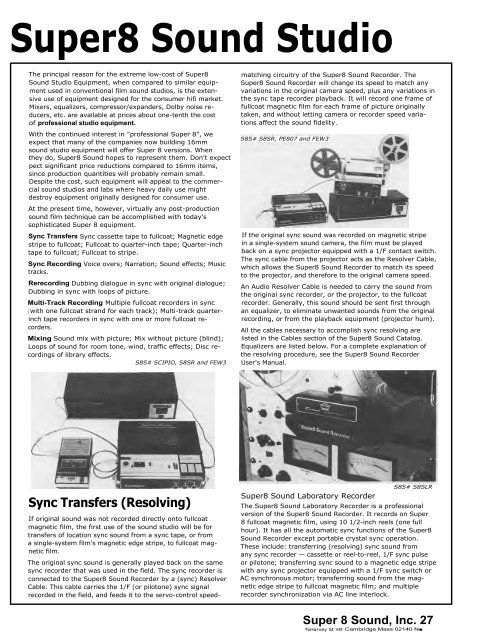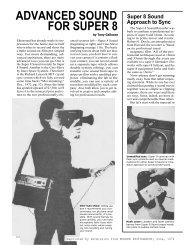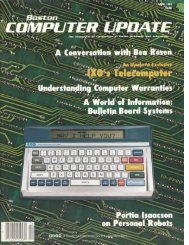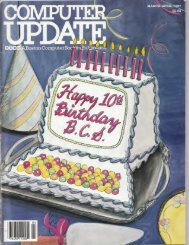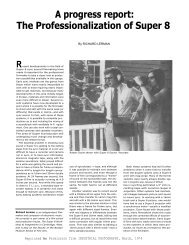Super 8 Sound Inc. - Desktop Video Group
Super 8 Sound Inc. - Desktop Video Group
Super 8 Sound Inc. - Desktop Video Group
You also want an ePaper? Increase the reach of your titles
YUMPU automatically turns print PDFs into web optimized ePapers that Google loves.
<strong>Super</strong>8 <strong>Sound</strong> Studio<br />
The principal reason for the extreme low-cost of <strong>Super</strong>8<br />
<strong>Sound</strong> Studio Equipment, when compared to similar equipment<br />
used in conventional film sound studios, is the extensive<br />
use of equipment designed for the consumer hifi market.<br />
Mixers, equalizers, compressor/expanders, Dolby noise reducers,<br />
etc. are available at prices about one-tenth the cost<br />
of professional studio equipment.<br />
With the continued interest in "professional <strong>Super</strong> 8", we<br />
expect that many of the companies now building 16mm<br />
sound studio equipment will offer <strong>Super</strong> 8 versions. When<br />
they do, <strong>Super</strong>8 <strong>Sound</strong> hopes to represent them. Don't expect<br />
pect significant price reductions compared to 16mm items,<br />
since production quantities will probably remain small.<br />
Despite the cost, such equipment will appeal to the commercial<br />
sound studios and labs where heavy daily use might<br />
destroy equipment originally designed for consumer use.<br />
At the present time, however, virtually any post-production<br />
sound film technique can be accomplished with today's<br />
sophisticated <strong>Super</strong> 8 equipment.<br />
Sync Transfers Sync cassette tape to fullcoat; Magnetic edge<br />
stripe to fullcoat; Fullcoat to quarter-inch tape; Quarter-inch<br />
tape to fullcoat; Fullcoat to stripe.<br />
Sync Recording Voice overs; Narration; <strong>Sound</strong> effects; Music<br />
tracks.<br />
Rerecording Dubbing dialogue in sync with original dialogue;<br />
Dubbing in sync with loops of picture.<br />
Multi-Track Recording Multiple fullcoat recorders in sync<br />
(with one fullcoat strand for each track); Multi-track quarterinch<br />
tape recorders in sync with one or more fullcoat recorders.<br />
Mixing <strong>Sound</strong> mix with picture; Mix without picture (blind);<br />
Loops of sound for room tone, wind, traffic effects; Disc recordings<br />
of library effects.<br />
S8S# SCIPIO, S8SR and FEW3<br />
Sync Transfers (Resolving)<br />
If original sound was not recorded directly onto fullcoat<br />
magnetic film, the first use of the sound studio will be for<br />
transfers of location sync sound from a sync tape, or from<br />
a single-system film's magnetic edge stripe, to fullcoat magnetic<br />
film.<br />
The original sync sound is generally played back on the same<br />
sync recorder that was used in the field. The sync recorder is<br />
connected to the <strong>Super</strong>8 <strong>Sound</strong> Recorder by a (sync) Resolver<br />
Cable. This cable carries the 1/F (or pilotone) sync signal<br />
recorded in the field, and feeds it to the servo-control speed-<br />
matching circuitry of the <strong>Super</strong>8 <strong>Sound</strong> Recorder. The<br />
<strong>Super</strong>8 <strong>Sound</strong> Recorder will change its speed to match any<br />
variations in the original camera speed, plus any variations in<br />
the sync tape recorder playback. It will record one frame of<br />
fullcoat magnetic film for each frame of picture originally<br />
taken, and without letting camera or recorder speed variations<br />
affect the sound fidelity.<br />
S8S# S8SR, PE807 and FEW3<br />
If the original sync sound was recorded on magnetic stripe<br />
in a single-system sound camera, the film must be played<br />
back on a sync projector equipped with a 1/F contact switch.<br />
The sync cable from the projector acts as the Resolver Cable,<br />
which allows the <strong>Super</strong>8 <strong>Sound</strong> Recorder to match its speed<br />
to the projector, and therefore to the original camera speed.<br />
An Audio Resolver Cable is needed to carry the sound from<br />
the original sync recorder, or the projector, to the fullcoat<br />
recorder. Generally, this sound should be sent first through<br />
an equalizer, to eliminate unwanted sounds from the original<br />
recording, or from the playback equipment (projector hum).<br />
All the cables necessary to accomplish sync resolving are<br />
listed in the Cables section of the <strong>Super</strong>8 <strong>Sound</strong> Catalog.<br />
Equalizers are listed below. For a complete explanation of<br />
the resolving procedure, see the <strong>Super</strong>8 <strong>Sound</strong> Recorder<br />
User's Manual.<br />
<strong>Super</strong>8 <strong>Sound</strong> Laboratory Recorder<br />
S8S# S8SLR<br />
The <strong>Super</strong>8 <strong>Sound</strong> Laboratory Recorder is a professional<br />
version of the <strong>Super</strong>8 <strong>Sound</strong> Recorder. It records on <strong>Super</strong><br />
8 fullcoat magnetic film, using 10 1/2-inch reels (one full<br />
hour). It has all the automatic sync functions of the <strong>Super</strong>8<br />
<strong>Sound</strong> Recorder except portable crystal sync operation.<br />
These include: transferring (resolving) sync sound from<br />
any sync recorder — cassette or reel-to-reel, 1/F sync pulse<br />
or pilotone; transferring sync sound to a magnetic edge stripe<br />
with any sync projector equipped with a 1/F sync switch or<br />
AC synchronous motor; transferring sound from the magnetic<br />
edge stripe to fullcoat magnetic film; and multiple<br />
recorder synchronization via AC line interlock.<br />
<strong>Super</strong> 8 <strong>Sound</strong>, <strong>Inc</strong>. 27<br />
%Harvey St r eet Cambridge Mass 02140 N■


